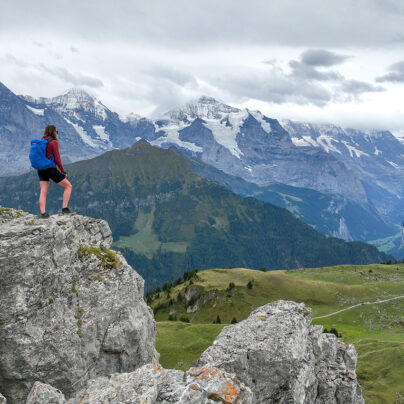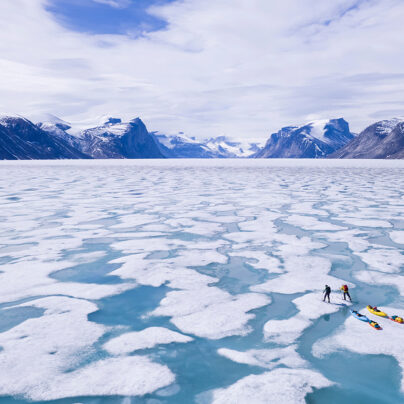Paddle and Portage in Patagonia
Will Copestake
Puerto Eden felt like a lost temperate rainforest in the heart of Patagonia’s ice-capped wilderness. These humble houses perched on rocky islands in a town without roads, connected only by boats and boardwalk, were the last refuge of the native Kawésqar people, the original canoe fishermen of the fjords.
Perched on the gunwale of a fishing boat I watched rain dancing on the water. At my side was Seumas, my best friend, who had flown from Scotland to join me in perhaps the only place on Earth wetter and windier than home. Catching a fleeting glance beneath his hood we shared the same unspoken thought: What are we doing here?
Famous for a record 9m and 361 days of rain per year, Puerto Eden felt like a lost temperate rainforest in the heart of Patagonia’s ice-capped wilderness. These humble houses perched on rocky islands in a town without roads, connected only by boats and boardwalk, were the last refuge of the native Kawésqar people, the original canoe fishermen of the fjords. Their tradition was to build fires inside their skin-on-frame canoes on a bed of clay to keep warm in the harsh climate: proof that you can have your kayak and heat it too!
We relied on a more modern approach, our low-volume kayaks loaded with 45 days of food, fuel and butter along with camping gear. They weighed over 120kg and flexed under their own overladen weight. For the next 840km we would depend on whatever we had fitted inside. There were no roads or escape routes between here and the end.
After two seasons as a local kayak guide I knew what to expect from Patagonia which, for lack of a better phrase, can be a beautiful bastard. I was once told that ‘to carve this landscape from heaven took the weather from hell’. As homage to the conditions we christened our boats Viento and La Rafagas – Wind and Spindrift.
‘That’s a penguin!’ Seumas shouted, unable to hide his excitement. We had just watched parakeets flying past and a hummingbird still whirred over my bow. Nothing was normal in this land of contrasts but we couldn’t help but wonder aloud, ‘What is this place?’
Following a north-south route to make best use of the prevailing winds we had paddled slowly beyond the town and into the committing wilderness. The shore at our side was dense forest or vertical granite. Slowly we were finding our rhythm and growing more confident. We hoped to break our race for the finish by taking three detours north in search of glaciers and a further three inland to portage across exposed headland.

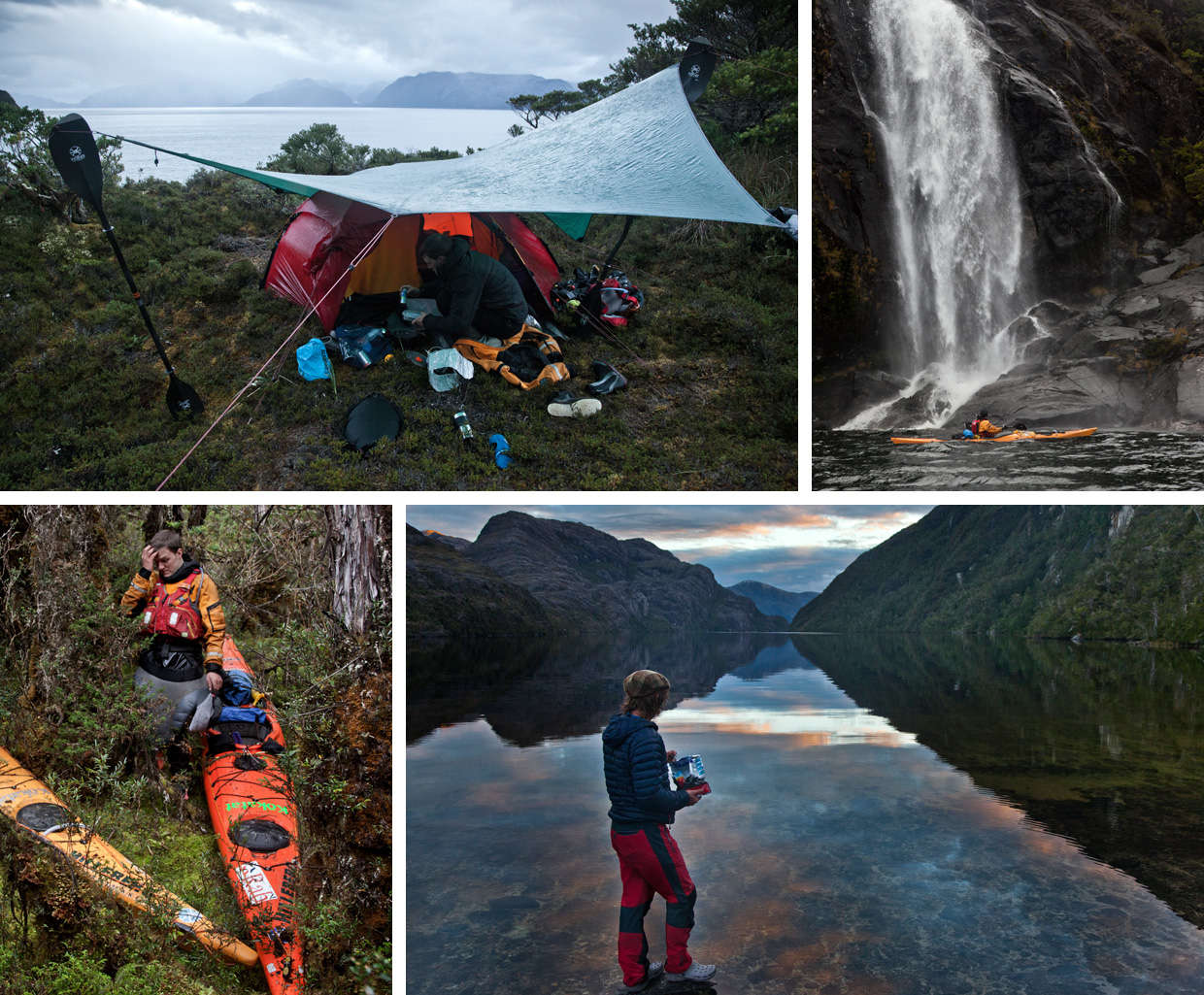
Seumas broke through the crest of a wave in an explosion of glittering spray which cast a rainbow abound his blades with the first sun we had seen in over a week. It was a seminal moment. The sea, dense with floury glacial silt, now radiated a creamy blue as the light burst through the breaking faces of steep waves. Silhouetted at our side, a giant storm petrel soared with graceful ease, its wing tips outstretched just inches from the waves, defiant to the elements. How I marvelled at its grace in seizing the wind that we fought so hard against. Driven by a distant ribbon of blue on the horizon we ducked when salty spray broke over our boats, determined to draw closer to Pio XI, South America’s largest glacier.
With a gut-wrenching roar, a tremendous column of mud-brown water rushed into the air, the noise like thunder as ice shattered against ice. We stood together in a safe place mere metres from the glacier that collapsed into a huge lagoon beneath us. Watching house-sized lumps of ice tumble to the end of their thousand-year journey from mountain to sea, we were drawn in by the sapphire crevasses left in the face behind – not a place for the living but a place to gaze at, awestruck, from afar.
‘Not bad for a first glacier, mate!’ I said with a chuckle to Seumas. We had by chance arrived at the perfect time, when the face some 11km long by 200m high was calving every few minutes. Our boats rested on the beach behind us, far from the impact zone and stuck fast in the viscous mud pushed by billions of tons of moving ice. The mud saturated my clothes and would remain there until the end nearly a month ahead.
After wiping ice from our tent the next day, we turned back south and settled into a daily rhythm. To think about the full 840km route was daunting and so we took each day on its own, broken down into easier tasks. We would wake up, paddle seven to nine hours until the light started to fade then find a camp, rest and repeat. I took upon the responsibility of setting camp and fetching water; Seumas took the task of lighting fires and cooking. Our discipline in keeping a dry space was key here – once wet our gear may not be dry again until we finished, so our tent became a bubble of comfort to hide inside after a long day. So long as we paddled more than 20km a day we would make it home on time with our rations, but by the end of the first week we were already several days ahead.
With a gut-wrenching roar, a tremendous column of mud-brown water rushed into the air, the noise like thunder as ice shattered against ice. We stood together in a safe place mere metres from the glacier that collapsed into a huge lagoon beneath us.


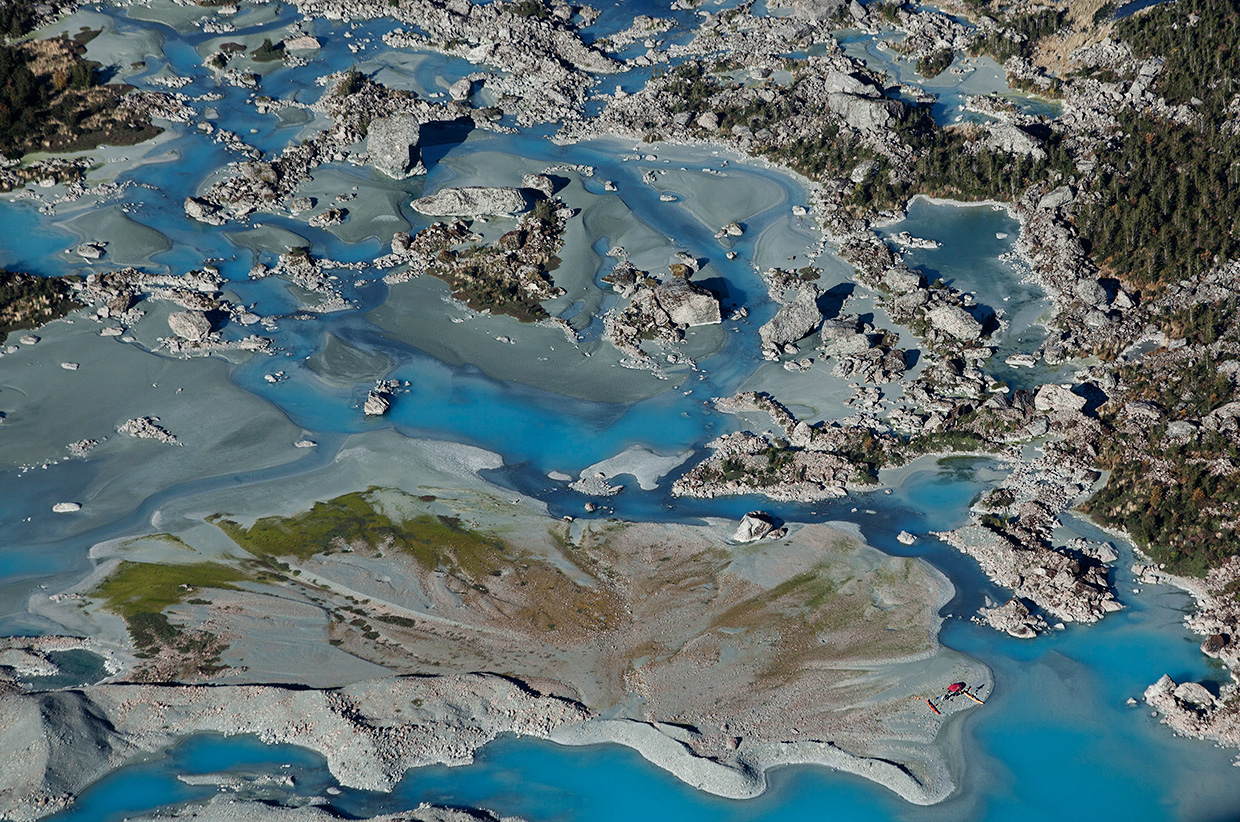

Sweating and panting for breath I clutched a bloodied hand on the bow of the boat. Progress was slow, and everything here was inexplicably covered in thorns that tore my skin as we moved – this felt like real adventure.
‘Gladiator!’ I shouted, quoting the early 90s TV show. ‘Ready!’ Seumas bellowed as we both heaved forward in a slow lurch, and our kayak slid forward another half metre. Our first portage was short but steep, a 40º incline through near-impenetrable undergrowth. Sweating and panting for breath I clutched a bloodied hand on the bow of the boat. Progress was slow, and everything here was inexplicably covered in thorns that tore my skin as we moved. Covered in mud, rosy cheeked and out of breath we were both smiling, for there was something strangely satisfying in the hard work – this felt like real adventure.
After lowering the boats on ropes into the shadow of a mountain we found our way onto a ribbon of water that cut across the headland: the lake that would guide our secret passage past the forecast strong winds on the headland we had avoided. Two days of paddling and dragging saw us spat into the sea on the far side by a swift river, the thrill of the rapids soon swapped for big seas and a stiff following wind.
After a week of testing conditions with waves breaking 2m, relentless rain and snow, we snuck back north to a narrow inlet known as Peel Fjord. The only other person I knew to have been there had described it as ‘mind blowing’, but we arrived to find icebergs and no mountains; they were lost in the mist.
‘Dude! Wake up!’ Silhouetted in the entrance of the tent, Seumas was gazing outside. To our surprise the sun had broken through the cloud. Outside, a low bank of mist glowed ethereal and gold in the morning light, mirrored in the calmest waters we had seen for days. This colosseum of mountain and ice dwarfed the icebergs now. Lingering to explore, we spent a day barely moving under a skyline of ragged spires and broken ice cap, the silent air booming and rumbling as icebergs crumbled to the sea. We were now 350km from anyone, in our own private paradise lost in the heart of the wild.
Thoughts turned to home as we steered back south once more. Then the weather changed. Stormbound for several days as snowstorms and gales passed, our route became a race to round the final committing corner. Broken only by a second portage, our days became brutal 40-50km pushes – we felt strong and wanted to show it to ourselves.
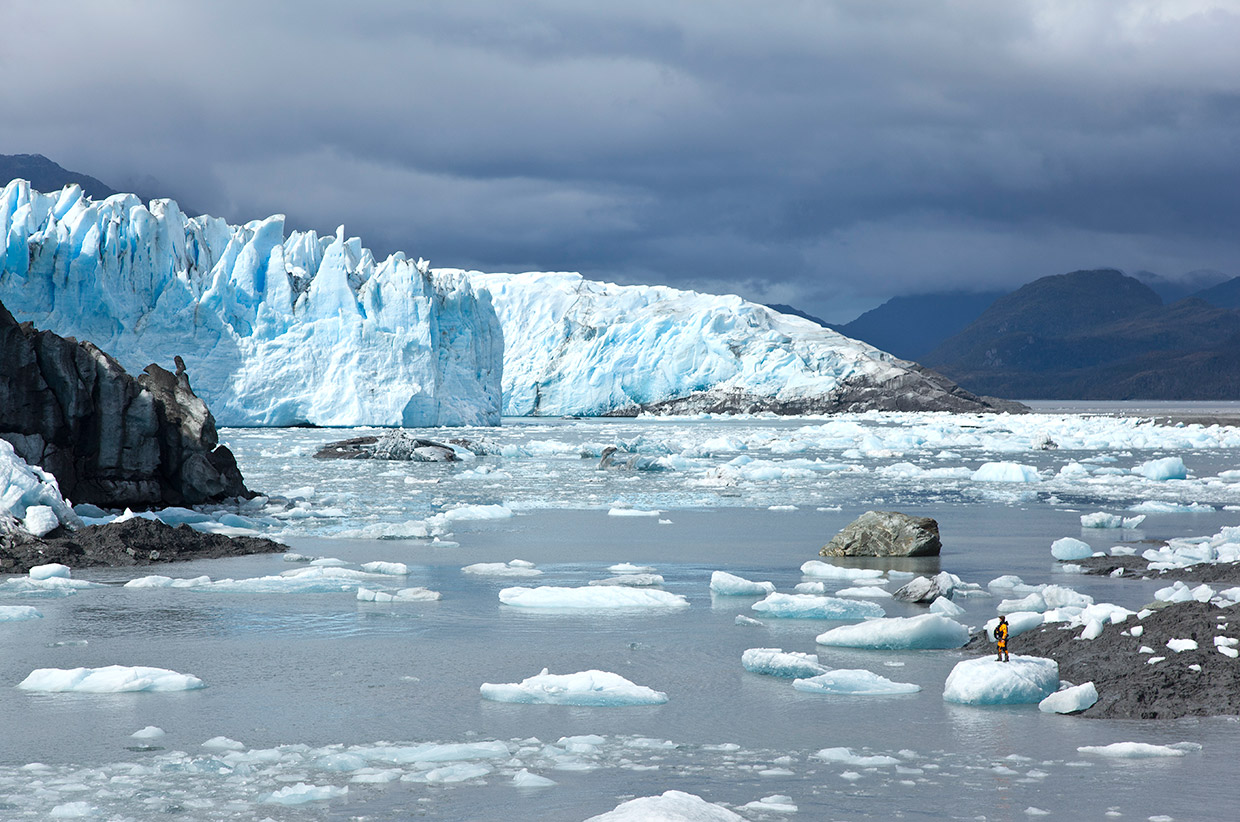


The Canal De Los Montañas (the canal of the mountains) was the first time I felt back on familiar ground. Just one year before I had sat stormbound for days with a client looking out at the channel. I remembered thinking how harsh it looked, how curious I was about what lay beyond but content in knowing I would never know – but now we did. To my surprise our perspective had changed: then it had felt like the end of the Earth, now we felt close to home.
We didn’t feel ready to go back yet. So, blessed by a final week of near-perfect conditions with sunshine and no wind, we decided to linger in the fjord. For a week we explored glaciers and dragged our boats up rivers. We set camp at the foot of the ice and climbed a mountain in wetsuit shoes just because. Our worries about reaching home were gone now and the love of adventure and all it entailed now filled our days with the same curious exploration we had relished together as kids growing up in Scotland. All that was left was the ‘short bog drag’ described by the locals for our final portage.
Nine hours later, 200m high and abseiling our kayaks on our towlines we chuckled and joked about the ‘easy’ drag we had been described. In reality it was wonderfully character building. Beyond the narrow gap we returned to the ocean and for the first time in a month saw open, unbroken sky. Ahead there were no more mountains but an empty horizon; behind us a wall of dark brooding cloud approached from the ragged chain of peaks in the distance. It was time to get back to civilisation.
It is not often that anyone gets the chance to truly lose contact with the world. In the fjords we had rarely seen signs of people except for the occasional boat in the distance. With no-one around but ourselves we had fallen into the rhythm of a routine driven by our surroundings. Our pace had changed.
‘Just listen to it,’ Seumas muttered. Through the still morning air the distant hum of humanity buzzed from rooftops far ahead. At that moment I was hesitant to get there, but I realised we were already planning our next adventure in the mountains beyond. Our expedition had been a success – for we finished still wanting more, still wanting to keep going.

Will Copestake is a freelance guide and adventurer. Born in the North of Scotland, Will’s love of the outdoors grew around a childhood spent on the local coast and hills. Since then Will has travelled around the world exploring New Zealand and Iceland on foot and kayaking in Patagonia and Norway. Will is best known for his ‘Machair to Munro’ expedition in his home country of Scotland which involved a 1600km solo kayak around the border before heading inland by bike to climb the 282 Munro mountains through the winter in a journey lasted 364 days.
Website: www.willcopestakemedia.com
Facebook: WillCopestakeMedia
Twitter: @WillCopestake
Instagram: @WillCopestake
Thanks to the following sponsors for their support:
Hilleberg // Rab // Powertraveller // Dhu Performance Cashmere
Kokatat // Werner




